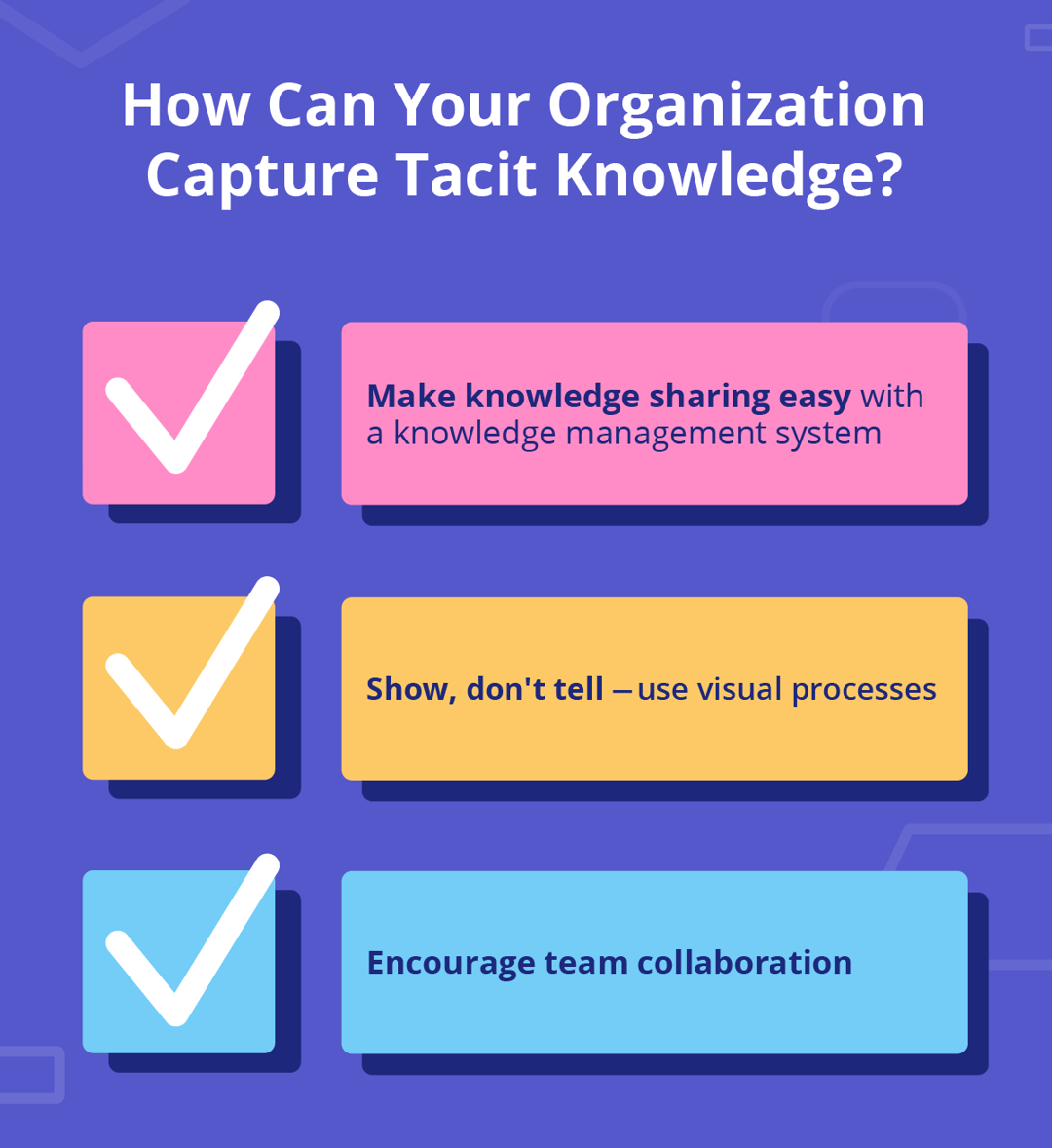How to Capture Tacit Knowledge from Your Employees

What would a company be without its knowledge?
Knowledge is the backbone of any successful organization, providing the necessary expertise to drive its purpose.
There is a common assumption that explicit knowledge, which is found in manuals, documents, files, and records, is the most crucial type of knowledge because it is easily captured and codified.
But that's not an absolute truth.
The true value and competitive advantage for an organization lies in its ability to capture tacit knowledge.
Capturing tacit knowledge may be a difficult task, but it could mean the difference between average employee performance and outstanding performance which empowers the employee and drives the organization's success.
What is tacit knowledge?
Tacit knowledge can be defined as information that is stored in the mind and gained through experience, intuition, judgment, innovation, and wisdom.
Tacit knowledge is typically held by tenured employees who have accumulated years of experience. New employees, on the other hand, often lack this knowledge and must learn through training and one on one coaching sessions.
Given that tacit knowledge is difficult to capture and communicate, when employees leave an organization, they take the invaluable information that they’ve gathered with them. New employees are forced to start from scratch, typically only equipped with explicit knowledge as they gradually build up their experience. This cycle can be detrimental to an organization's success, as it leads to the loss of critical expertise.
What are some examples of tacit knowledge?
Tacit knowledge plays a crucial role in our ability to navigate and excel in different areas of life.
Here are a few specific real-world examples.
- Judgment tells a salesperson how to negotiate when a prospect has objections. When the salesperson leaves the organization, the new hire won’t find the same information on negotiating in the training manual and may lose out on deals.
- Experience of a chef helps them understand exactly when to adjust the temperature. When a new chef is hired, this knowledge can’t be duplicated by following a recipe, so the same menu item might end up tasting different.
- Intuition when learning a language that can only be gained through exposure to a native speaker. When the student no longer has access to the native speaker, they won’t find the same knowledge in a textbook.
Why you need to capture tacit knowledge
Your employees are creative and resourceful, and when they're able to share their knowledge it continues to benefit everyone in the organization long after they leave.
For example, when someone comes up with a new way to reduce average handle time (AHT), sharing this information with the rest of the team will help improve the productivity of low and average performing employees. Even new employees will gain expert skills faster and be more engaged with their work.
The benefit of capturing tacit knowledge goes beyond improving productivity, it also helps reduce the long and often frustrating process of new employee onboarding. With expert knowledge at their disposal, new hires can reach proficiency and contribute to the organization’s success much sooner.
Why is it so difficult to capture tacit knowledge?
Did you know that 80% of knowledge is tacit?
Transferring tacit knowledge into explicit knowledge is one of the most challenging tasks of knowledge management for several reasons.
Without the proper tools to share and capture tacit knowledge, employees struggle to communicate what they know.
In addition, a competitive environment can create reluctance to share knowledge that an employee believes gives them an edge. Employees may not even realize that they have knowledge worth sharing until they see the reactions of others when they’re guided through a work-related scenario.
The rise of remote work has also contributed to the challenge of capturing tacit knowledge. When employees don’t engage face-to-face, communication can become limited to only necessary messages, creating silos of knowledge within the organization.
Top 3 ways to effectively capture tacit knowledge
Capturing tacit knowledge is difficult, but not impossible.
Below are three ways to capture tacit knowledge and share it with your employees.
1. Make knowledge sharing easy
To capture tacit knowledge, employees require a system that allows them to easily share their knowledge with one another. That's why a centralized knowledge management platform is an essential tool for capturing, storing, and sharing knowledge within an organization. It allows employees to easily access and build on the insights of others and makes knowledge capture a seamless part of the everyday workflow.
A knowledge management platform also enables employees to submit their knowledge for review and approval, ensuring that all information shared is accurate and up-to-date, and that valuable information is not lost. This fosters a culture of continuous learning and improvement, empowering employees to contribute to the success of the organization.
2. Show, don’t tell
Humans are visual learners. A study published by Microsoft reveals that the use of visual processes increases retention dramatically when compared to traditional reading methods.
Capturing tacit knowledge through visuals such as diagrams, flowcharts, and mind maps is an effective way to share knowledge by helping employees visualize the thought process.
Interactive learning is another excellent way to capture tacit knowledge by visually demonstrating processes. New hires can receive hands-on experience by observing their colleagues performing specific tasks. Similarly, recording and showing videos of processes helps new employees visually understand the nuances of their role.
3. Encourage team collaboration
A collaborative environment where employees are encouraged to share their knowledge increases the productivity and morale of the entire organization. Although some employees might hesitate to reveal their knowledge, it is important to demonstrate how their willingness to collaborate helps the entire team.
When all employees, regardless of their level, are performing at their best, the organization is much more likely to achieve long-term success and retain top talent.
Bonus tip: Motivate employees to share and capture their knowledge by providing incentives and rewards such as giving them a shoutout on the company news channel or treating them to a free lunch.
Capture tacit knowledge from your employees
Knowledge is power and the ability to capture tacit knowledge is an essential component of unlocking the full potential of your workforce.
With a robust knowledge management system like Procedureflow, your organization will be equipped with the tools it needs to seamlessly capture, store, and share knowledge from day one.


